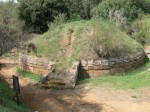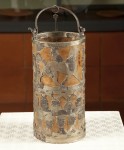 The 7th century B.C. Regolini-Galassi tomb in the Etruscan necropolis of Cervetri and the 300 artifacts discovered inside of it were laser scanned and digitized for a virtual museum exhibit in 2011. I wrote about it when the reconstruction debuted at the Allard Pierson Museum in Amsterdam and the National Museum for Antiquities in Leiden, and we were fortunate to get a review from Richard who commented that although there was a lot of good information and it was cool to see the tomb laid out in its original configuration, the interface was somewhat unwieldy and moved at its own pace regardless of user preference.
The 7th century B.C. Regolini-Galassi tomb in the Etruscan necropolis of Cervetri and the 300 artifacts discovered inside of it were laser scanned and digitized for a virtual museum exhibit in 2011. I wrote about it when the reconstruction debuted at the Allard Pierson Museum in Amsterdam and the National Museum for Antiquities in Leiden, and we were fortunate to get a review from Richard who commented that although there was a lot of good information and it was cool to see the tomb laid out in its original configuration, the interface was somewhat unwieldy and moved at its own pace regardless of user preference.
 After that first display, the CNR-ITABC (National Council of Research – Institute for Technologies Applied to Cultural Goods) in Rome spent more than a year working on a new version of the Etruscanning3D application. The updated software was brought to the Italian Science Festival in Genoa and the ArcheoVirtual exhibition in Paestum in November of 2012 where flocks of children and adults took it for a spin. It won an award for best new application at ArcheoVirtual exhibition and was voted the favorite of the visitors.
After that first display, the CNR-ITABC (National Council of Research – Institute for Technologies Applied to Cultural Goods) in Rome spent more than a year working on a new version of the Etruscanning3D application. The updated software was brought to the Italian Science Festival in Genoa and the ArcheoVirtual exhibition in Paestum in November of 2012 where flocks of children and adults took it for a spin. It won an award for best new application at ArcheoVirtual exhibition and was voted the favorite of the visitors.
The new version addresses the main issue Richard raised in his comment: it allows the user to navigate the virtual tomb freely. Instead of being taken through the tomb and having artifacts described in groups, users can now walk at their own pace and select individual objects to find out more about them. The tomb also contains considerably more artifacts than the first version did, all of them digitally restored so they look like they did when in the 7th century B.C.
 This entry describes the digital restoration of a situla, a cylindrical ritual bucket made of wood with a silver cover of animals and palmettes. They used turntable photography to create an all-around picture that could be unwrapped, then they created a displacement map which simulates surface details like the embossed and engraved silver designs. Once the details were laid out clearly in the unwrapped image, the team was able to see how the shapes were hammered and then recreate that same texture to fill in the missing spaces.
This entry describes the digital restoration of a situla, a cylindrical ritual bucket made of wood with a silver cover of animals and palmettes. They used turntable photography to create an all-around picture that could be unwrapped, then they created a displacement map which simulates surface details like the embossed and engraved silver designs. Once the details were laid out clearly in the unwrapped image, the team was able to see how the shapes were hammered and then recreate that same texture to fill in the missing spaces.
 CNR-ITABC has continued to improve the application, adding more artifacts and more flexibility. A version using a Kinect camera and floor hotspots is debuted in March as part of the exhibition on the Etruscans at the Gallo-Roman museum in Tongeren, Belgium. As of Wednesday, April 3rd, the virtual Regolini-Galassi tomb was officially installed at the Vatican Museums where the full collection of real-life artifacts from the tomb are on permanent display.
CNR-ITABC has continued to improve the application, adding more artifacts and more flexibility. A version using a Kinect camera and floor hotspots is debuted in March as part of the exhibition on the Etruscans at the Gallo-Roman museum in Tongeren, Belgium. As of Wednesday, April 3rd, the virtual Regolini-Galassi tomb was officially installed at the Vatican Museums where the full collection of real-life artifacts from the tomb are on permanent display.
The virtual experience is still not available in its entirety online. The video clip in my original post (now no longer accessible) was in Dutch, but here’s a video of the new version of the application in English which shows how a user navigates the tomb using hotspots in the floor and the simplest of arm gestures.
[youtube=http://youtu.be/iiW4dbfo5yU&w=430]
Absolutely Etrus-cunning. The combination of a winged lion and a griffin seems to be ubiquitous in art history. Moreover, in northern Italy they are still in use in Grosseto (griffin) and Veneto (winged lion). … I nearly kicked the ‘situla’ when in the video all of a sudden the little girl switched on the volume.
Kicked the situla… 😆 I think that’s your greatest obscure historical pun ever.